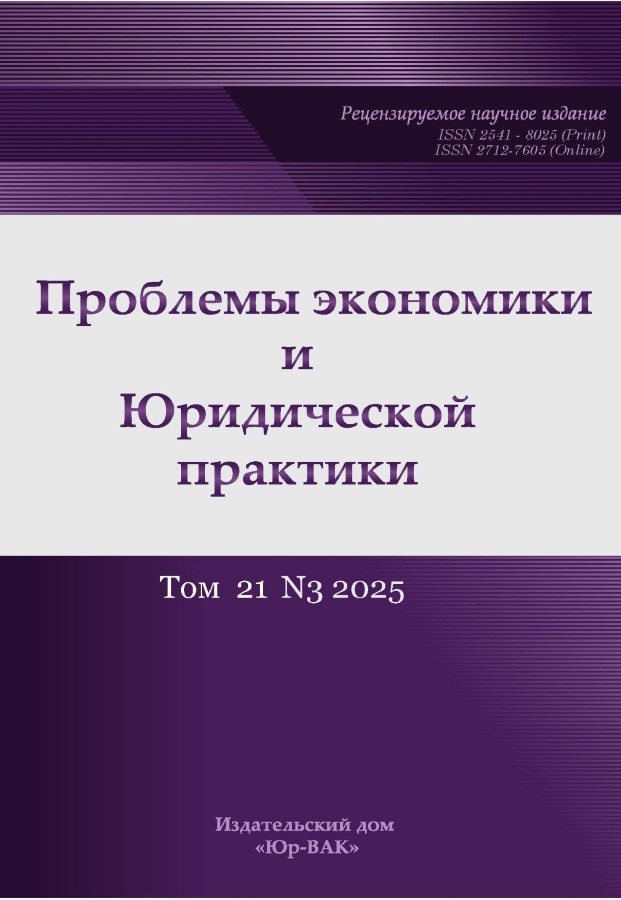Counteracting the Involvement of Young People in Schemes for the Legalization (Laundering) of Proceeds from Crime
- 作者: Babanskaya A.S.1
-
隶属关系:
- Financial University under the Government of the Russian Federation
- 期: 卷 21, 编号 3 (2025)
- 页面: 229-238
- 栏目: Regional and Sectoral Economics
- URL: https://journals.eco-vector.com/2541-8025/article/view/688203
- DOI: https://doi.org/10.33693/2541-8025-2025-21-3-229-238
- EDN: https://elibrary.ru/sadjit
- ID: 688203
如何引用文章
详细
In the context of growing digitalization of the economy and the spread of Internet technologies, young people are becoming vulnerable to manipulation by criminal groups; the practice of involving young people in illegal schemes for the legalization (laundering) of proceeds from crime is growing. The study is aimed at identifying the factors contributing to the involvement of young people in these schemes, an analysis of approaches to counteracting the involvement of young people in money laundering schemes in Russia and foreign countries is conducted, and recommendations are proposed for the prevention of youth involvement in schemes for the legalization of proceeds from crime.
全文:
作者简介
Anastasia Babanskaya
Financial University under the Government of the Russian Federation
编辑信件的主要联系方式.
Email: banasti@mail.ru
SPIN 代码: 4992-3607
Scopus 作者 ID: 57216711030
Cand. Sci. (Econ.), Associate Professor, Associate Professor, Department of Eco-nomic Security and Risk Management
俄罗斯联邦, Moscow参考
- Aslanov V. G. Cyber fraud in settlements with bank cards // Innovations. 2022. 52. 321–330.
- Akhatova A. M. Drop as an accomplice to crimes committed using information and telecommunication networks: problems of criminal-legal assessment and law enforcement // Bulletin of Udmurt University. Series Economics and Law. 2024. 34 (6). 1075–1083.
- Babanskaya A.S., Grudneva A.A. Analysis and assessment of financial risks // Accounting in agriculture. 2020. 4. 66–75.
- Babanskaya A.S., Suleimanov R.A. Shadow processes in the economy // Collection: Interaction of science and business. Keynes Laboratory of Applied Economic Research, 2015. 12–15.
- Bayramkulova D.R. Factors of attracting minors to commit crimes // Legal science. 2022. 5. 93–97. URL: https://cyberleninka.ru/article/n/faktory-privlecheniya-nesovershennoletnih-k-soversheniyu-prestupleniy (date of access: 20.05.2025).
- Burenkova E.O. Current state and trends of juvenile delinquency in the Russian Federation // Bulletin of PenzSU. 2020. 1 (29). 30–35. URL: https://cyberleninka.ru/article/n/sovremennoe-sostoyanie-i-tendentsii-prestupnosti-nesovershennoletnih-v-rossiyskoy-federatsii (date of access: 20.05.2025).
- Kasyan Z.A. Social regulation of marginalization of Russian youth: institutional aspect // Society: politics, economics, law. 2009. 1–2. 71–74. URL: https://cyberleninka.ru/article/n/sotsialnaya-regulyatsiya-marginalizatsii-rossiyskoy-molodezhi-institutsionalnyy-aspekt (date of access: 20.05.2025).
- Rogach O.V., Frolova E.V. Analysis of the influence of social networks on modern teenagers: key problems and destructive consequences // Bulletin of Perm University. Philosophy. Psychology. Sociology. 2022. 2. 305–314. https://doi.org/10.17072/2078-7898/2022-2-305-314.
- Shestak V. A., Chebotar A. S. Budapest Convention as a fundamental mechanism for combating cybercrime: innovations and prospects for international legal regulation // Education and Law. 2023. 8. 305–310.
- Akartuna E., Johnson S., Thornton A. Preventing the money laundering and terrorist financing risks of emerging technologies: An international policy Delphi study // Technological Forecasting and Social Change, 2022. 179. https://doi.org/10.1016/j.techfore.2022.121632.
- Akers R. L. Social learning theory // In book: Analytical Criminology. USA: Roxbury Publishing Company. May 2020. https://doi.org/10.4324/9780429026980-11.
- Dalhat M. A., Surajo A., Jafaru A. An appraisal of youths' cybercrime in Nigeria: challenges and prospects. Conference: 3rd International Conference & Doctoral Colloquium organized by the Faculty of Management Sciences, Bayero University, Kano at Dantata Business School, BUK New Site Kano, Nigeria. At: Kano. December 2022.
- FATF. Money Laundering Using New Payment Methods. October 2010. URL: https://www.fatf-gafi.org/en/publications/Methodsandtrends/Moneylaunderingusingnewpaymentmethods.html.
- Ige O. A. Secondary school students’ perceptions of incidences of internet crimes among school age children in Oyo and Ondo States, Nigeria // The African Symposium: Anonline Journal of African Educational Research Network Volume 9. No. 2. December 2009. https://doi.org/10.5281/zenodo.14599741.
- Lu Y., Steffensmeier D. Stability or Change in Age-Crime Relation in Taiwan, 1980–2019: Age-Period-Cohort Assessment // Asian Journal of Criminology. 2023. 18. 1–26. https://doi.org/10.1007/s11417-023-09412-y.
- Ogunleye Y., Ojedokun U., Aderinto A. Pathways and Motivations for Cyber Fraud Involvement among Female Undergraduates of Selected Universities in South-West Nigeria // International Journal of Cyber Criminology. 2020. 13. 309-325. https://doi.org/10.5281/zenodo.3702333.
- Pulungan A., Setiawan H., Windiarti F. The Risk of Corruption and Money Laundering // An Analysis of Personal Predespositions and Socio-economic, 2024. 121–136. https://doi.org/10.61093/sec.8(4).121-136.2024.
- Rosanwo O. Students' perception and increasing rate of cybercrime among Obafemi Awolowo University undergraduates. 2023. July 31. 1–96. https://doi.org/10.5281/zenodo.14599741.
- Saharan M. Investigating the Relationship Between Awareness and Willingness to Engage in Money Mule Activities: A Conceptual Analysis // International Journal of Research and Innovation in Social Scienc. 2024. 8. 260–268. https://doi.org/10.47772/IJRISS.2024.8100021.
补充文件















